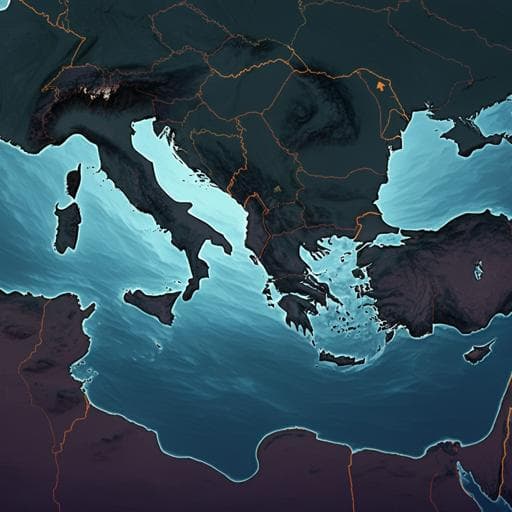
Environmental Studies and Forestry
Exploring spatial feedbacks between adaptation policies and internal migration patterns due to sea-level rise
L. Reimann, B. Jones, et al.
This groundbreaking study by Lena Reimann and colleagues reveals that climate change-induced sea-level rise could spark the migration of up to 20 million people in the Mediterranean by 2100, with adaptation strategies playing a crucial role in mitigating this massive internal shift. Discover how socioeconomic factors influence these migration patterns!
~3 min • Beginner • English
Introduction
The study investigates how sea-level rise (SLR), socioeconomic development, and coastal adaptation policies interact to shape internal migration patterns and magnitudes. While climate change is expected to increase both internal and international migration, most movements are likely to be internal and over short distances, often reinforcing existing rural-to-urban trends. Coastal zones are densely populated and highly attractive, making them particularly vulnerable to SLR impacts such as submergence, erosion, saltwater intrusion, and increased coastal flooding. Existing supra-national studies often assume autonomous migration of populations exposed to SLR and rarely integrate diverse adaptation strategies (protection, accommodation, managed retreat) into migration assessments. The research aims to fill this gap by exploring how different adaptation policy scenarios affect the number, timing, and spatial distribution of SLR-induced internal migration in the Mediterranean through integrated RCP-SSP-SPA scenarios, emphasizing spatial feedbacks like the levee effect.
Literature Review
The literature indicates consensus that climate change will affect migration by altering environmental, economic, social, political, and demographic drivers. Internal migration is expected to dominate, often from rural to urban areas. Prior global and regional assessments have estimated large numbers of climate-related internal migrants by mid- to late-century, but few have assessed SLR-related migration while explicitly incorporating adaptation strategies at supra-national scales. Some global studies include limited hard protection or managed retreat assumptions, but integrated assessments across protection, accommodation, and retreat remain scarce. Spatial patterns of internal migration under climate impacts have been more frequently analyzed at national/local scales due to data availability, leaving supra-national spatial dynamics underexplored. The literature also highlights the safe development paradox (levee effect), whereby protection measures can increase coastal attractiveness and exposure. This study responds to calls for integrating adaptation policy scenarios into migration modeling and for identifying spatial hotspots to aid planning.
Methodology
The study extends the gravity-based, spatial population downscaling model CONCLUDE to incorporate SLR impacts and adaptation policies. CONCLUDE operates at 30 arc-second (~1 km) resolution with decadal time steps, distributing national-level population and urbanization trajectories spatially based on population potential (distance-decay and local attractiveness), calibrated/validated for the Mediterranean. Baseline population inputs use GHS-POP rasters (2019 version) and SSP-consistent national population and urbanization projections. Integrated scenarios combine three SSP-RCP pairs: SSP1-RCP2.6, SSP3-RCP4.5, SSP5-RCP8.5, each with and without adaptation SPAs. SLR-induced submergence is modeled via a bathtub approach using regionalized median SLR projections (relative to 1986–2005) of 0.31 m (RCP2.6), 0.42 m (RCP4.5), and 0.56 m (RCP8.5) by 2100 (Kopp et al.). SLR is spatially attributed to ~12,000 Mediterranean Coastal Database (MCD) segments; submergence is computed with MERIT DEM (3 arc sec). Submerged land is removed from habitable area each decade; populations in submerged cells migrate autonomously and are reallocated according to population potential, allowing for multiple displacements over time. Adaptation policy scenarios (SPAs) reflect differing intensities and mixes of hard protection, accommodation (setbacks, wetland restoration), and managed retreat, tailored for northern vs southern/eastern Mediterranean to reflect adaptive capacity differences. Hard protection locations are selected using DIVA’s demand-for-safety function, then post-processed to reflect Mediterranean context and SPA narratives by applying population density thresholds (stricter in the South/East) and excluding rural segments where appropriate. Resulting protected coastline: 2693 km (Build with Nature; ~5%), 1596 km (Save Yourself; ~3%), 14,574 km (Hold the Line; ~27%). Protection is assumed built in 2020 and raised with SLR without new additions. Accommodation includes setback zones where no hard protection exists: coastline buffers approximating ICZM (Build with Nature: ~150 m; Hold the Line: ~75 m; none in Save Yourself), plus additional setbacks for regular flooding and coastal wetland restoration (Build with Nature), using ESL return periods (North: 50-year; South/East: 25-year), GLWD coastal wetlands and high-resolution salt marsh data with buffers, filtered by population density (<300 people/km²) and floodplain location. Managed retreat is included in Build with Nature in unprotected frequently flooded areas (North: 5-year ESL; South/East: 2-year ESL). Adaptation layers are generated at 3 arc sec and aggregated to 30 arc sec with fractional coverage, then used to mask development or trigger relocations. Migration hotspots are identified per scenario using the top/bottom decile of in/out migration cells and combined across six scenarios (with/without adaptation) to classify high/medium/low confidence hotspots.
Key Findings
- Without adaptation policies, SLR-induced submergence may generate over 20 million internal migrants in the Mediterranean by 2100, largely independent of SSP-RCP combination. In SSP1-RCP2.6 the largest increases occur late-century; in SSP3-RCP4.5 and SSP5-RCP8.5 increases occur earlier due to earlier SLR acceleration. - With adaptation, cumulative migrants to 2100 are reduced by factors of approximately 1.7 (Build with Nature, SSP1-RCP2.6), 1.4 (Save Yourself, SSP3-RCP4.5), and 9 (Hold the Line, SSP5-RCP8.5), with Hold the Line yielding the lowest total (~2 million). Build with Nature shows earlier, proactive migration (about 3 million by 2020 rising gradually to ~12 million by 2100), while Save Yourself grows to ~15 million by 2100, mostly autonomous. - Decadal flows show a mid-century tipping point without adaptation where around 5 million migrate in a decade, occurring earlier in SSP3-RCP4.5 and SSP5-RCP8.5; at those tipping points, 82–90% of migrants are in Egypt (Nile Delta). - Urban migrants dominate: without adaptation, 70–86% of migrants are urban; with adaptation, the urban share drops to 56–68% as protection is concentrated in urban areas. - Regional disparities: without adaptation, cumulative migration by 2100 is roughly three times higher in the southern/eastern Mediterranean (about 14–15 million) than in the northern Mediterranean (about 5–6 million). With adaptation, South/East still exceeds North by ~3 million in Build with Nature (7.5 vs 4.5 million) and almost threefold in Save Yourself (11 vs 4 million). Adaptation reduces migration by 23–79% in the North and 29–94% in the South/East, depending on scenario. - Spatial patterns are robust across scenarios: strong out-migration from a narrow coastal strip and widespread in-migration into urban areas. Adaptation often reverses some SLR-driven patterns by inducing population growth in protected coastal segments (levee effect), especially under Hold the Line and in South/East under Save Yourself. Migration to protected coasts largely originates from urban areas, including inland cities like Damascus, Jerusalem, and Cairo. - Hotspot analysis across six scenarios shows consistent out-migration along narrow coastal strips and in-migration into major urban centers; adaptation alters but does not eliminate many hotspots (notably in the Nile Delta).
Discussion
The findings show that socioeconomic pathways (urbanization patterns, urban sprawl, adaptive capacity) can have a stronger influence on total SLR-induced internal migration than the precise magnitude of SLR, underscoring the importance of adaptation policy choices. Adaptation consistently reduces migrant numbers but can create a levee effect: protected coastlines attract population, increasing residual risk should defenses fail, particularly under large-scale protection (Hold the Line). Build with Nature balances hard protection in dense urban areas with accommodation (setbacks, wetland restoration) and managed retreat, leading to proactive, managed migration and lower long-term residual risk under low SLR. Save Yourself’s limited protection leads to reactive, largely autonomous migration and potentially high damages, with risks of trapped populations in less developed South/East countries. Robust spatial patterns (coastal out-migration and urban in-migration) across scenarios suggest stable hotspots for planning, but policy design must account for feedbacks that can shift risk to protected coasts. Overall, integrating adaptation policies into migration modeling clarifies how different strategies influence timing, type (proactive vs reactive; managed vs autonomous), and spatial redistribution of populations, informing anticipatory governance of migration and coastal risk.
Conclusion
The study advances supra-national, spatially explicit modeling of SLR-related internal migration by integrating RCP-SSP-SPA scenarios and capturing feedbacks between adaptation policies and migration using the CONCLUDE model. It shows that adaptation can substantially reduce migrant numbers but may induce a levee effect concentrating population and residual risk in protected coastal areas, while spatial migration patterns (coastal out-migration, urban in-migration) remain robust across scenarios. Policy implications include the need to evaluate not only migrant numbers but also the nature and management of migration and residual risk. Future research should refine adaptation policy scenarios at national/local scales; incorporate social vulnerability and heterogeneity (including trapped populations); combine top-down gravity-based models with bottom-up agent-based models to capture individual decision-making and dynamic feedbacks; conduct systematic sensitivity analyses across data, SLR projections, and modeling approaches; improve elevation, settlement, and protection datasets; and develop calibration/validation using observed migration flows, surveys, and novel data sources (e.g., mobile phone data). Extending assessments to other climate hazards (droughts, heat) within the same framework is also recommended.
Limitations
- Scenario uncertainty: Only three integrated SSP-RCP-SPA combinations were explored; while chosen to span plausible ranges, they may not capture the full uncertainty space. Adaptation policies are assumed effective from 2020 through 2100, despite real-world lead times and maintenance needs. Managed retreat zones were designated using expert judgment and ESL return periods due to lack of guidelines. - Modeling assumptions: The gravity-based approach captures aggregate tendencies toward dense, nearby locations but may not represent temporary displacements, return migration, or potential long-distance inland moves. The model does not explicitly constrain migration distances and cannot incorporate dynamic changes in coastal attractiveness under increasing SLR. Validation against observed SLR-related migration is limited due to sparse empirical evidence and current absence of comparable adaptation policies. - Data uncertainty: Median SLR values used are on the low end of AR6 ranges, potentially yielding conservative migrant estimates. MERIT DEM-based floodplain delineation and bathtub approach have known limitations; lack of consistent data on existing protection forced the assumption that land below mean sea level is submerged at the initial step, inflating early-century migrants in no-adaptation scenarios. GHSL population/settlement rasters carry uncertainties in spatial allocation and urban definitions. - Adaptation representation: Protection siting via DIVA was post-processed to reflect Mediterranean contexts; economic feasibility was not explicitly modeled. Protection is assumed built in 2020 and raised with SLR with no additional segments added; spatial feedbacks between evolving population distributions and protection siting were not iteratively modeled. - No systematic sensitivity analysis was conducted to apportion uncertainties from scenarios, data choices, and model structure.
Related Publications
Explore these studies to deepen your understanding of the subject.







